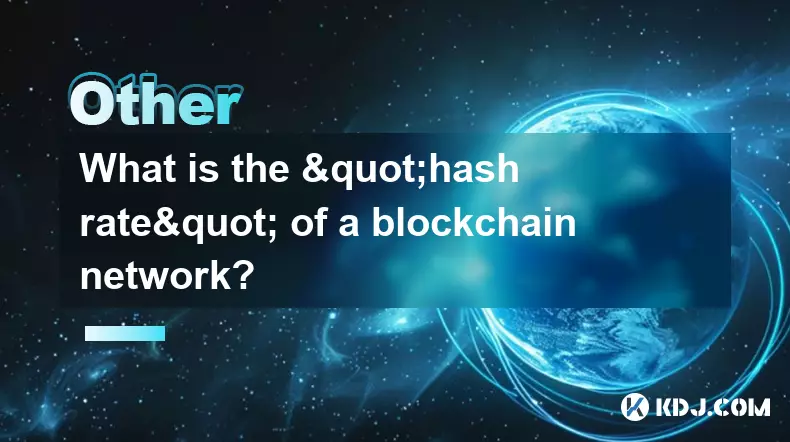-
 bitcoin
bitcoin $115692.075601 USD
5.13% -
 ethereum
ethereum $4162.931611 USD
11.68% -
 bnb
bnb $1310.063287 USD
17.56% -
 tether
tether $1.000983 USD
0.00% -
 xrp
xrp $2.534505 USD
8.16% -
 solana
solana $198.235737 USD
13.49% -
 usd-coin
usd-coin $1.000236 USD
0.02% -
 dogecoin
dogecoin $0.207352 USD
12.89% -
 tron
tron $0.323043 USD
3.62% -
 cardano
cardano $0.701559 USD
11.88% -
 hyperliquid
hyperliquid $39.924597 USD
8.30% -
 chainlink
chainlink $18.934457 USD
11.56% -
 ethena-usde
ethena-usde $1.000552 USD
0.02% -
 stellar
stellar $0.340575 USD
7.05% -
 bitcoin-cash
bitcoin-cash $545.011757 USD
8.86%
What is the "hash rate" of a blockchain network?
A high hash rate enhances blockchain security by making 51% attacks prohibitively expensive, reflecting robust network participation and computational power.
Oct 10, 2025 at 03:55 pm

Understanding Hash Rate in Blockchain Networks
1. The hash rate refers to the total computational power being used to process transactions and mine new blocks on a blockchain network, particularly those utilizing Proof of Work (PoW) consensus mechanisms. It measures how many calculations a mining device or network can perform per second when solving complex cryptographic puzzles required to validate transactions.
2. A higher hash rate indicates that more miners are actively participating in the network, contributing their computing resources to secure the system. This directly enhances the overall security of the blockchain because an attacker would need to control a majority of the network’s total hash rate—commonly known as a 51% attack—to manipulate transaction history.
3. Hash rates are typically measured in hashes per second, with common units including kilohashes (KH/s), megahashes (MH/s), gigahashes (GH/s), terahashes (TH/s), and even petahashes (PH/s). For example, Bitcoin's network currently operates at several hundred exahashes per second (EH/s), reflecting its massive global mining infrastructure.
4. Fluctuations in hash rate can signal changes in miner profitability, electricity costs, hardware advancements, or regulatory developments across regions. When the price of a cryptocurrency drops significantly, less efficient miners may shut down operations, leading to a temporary decline in the network’s total hash rate.
5. Mining pools often aggregate individual miners’ hash power to increase their chances of successfully mining a block and earning rewards. These collective efforts contribute to the decentralization—or sometimes centralization—of hash distribution depending on how concentrated the pool ownership becomes over time.
The Role of Hash Rate in Network Security
1. A consistently high hash rate makes it economically impractical for malicious actors to launch attacks on the blockchain. The cost of acquiring enough computing power to overpower the network becomes prohibitively expensive, especially on large networks like Bitcoin.
2. Sudden drops in hash rate can raise red flags within the community, suggesting potential instability or vulnerabilities. If a significant portion of miners go offline due to external factors such as government bans or energy shortages, the remaining network may become more susceptible to short-term disruptions.
3. Long-term growth in hash rate generally correlates with increased trust in the blockchain’s resilience. Investors and users view a robust hash rate as evidence that the network is well-protected against tampering and double-spending attempts.
4. Some smaller cryptocurrencies have experienced successful 51% attacks precisely because their hash rates were too low to deter attackers. In these cases, relatively inexpensive mining equipment was sufficient to gain control over the network temporarily, allowing fraudulent transactions to be confirmed.
5. Developers of PoW-based blockchains often monitor hash rate trends closely to assess the health of the ecosystem. Anomalies in hash rate data can prompt investigations into possible centralization risks or signs of coordinated manipulation by large mining entities.
Factors Influencing Hash Rate Variability
1. Cryptocurrency market prices heavily influence miner participation. As the value of a coin rises, more miners are incentivized to join the network, driving up the hash rate. Conversely, prolonged bear markets can lead to reduced mining activity and lower overall computational output.
2. Advancements in mining hardware technology directly impact hash rate efficiency. Newer application-specific integrated circuits (ASICs) offer substantially higher performance compared to older models or GPU-based systems, enabling miners to achieve greater hash output with less energy consumption.
3. Energy costs play a critical role in determining where mining operations are located. Regions with cheap electricity, such as parts of China, Russia, or the Middle East, tend to attract large-scale mining farms, contributing disproportionately to the global hash rate.
4. Regulatory policies affect hash rate distribution across countries. When governments impose restrictions on cryptocurrency mining or ban it outright, miners relocate their operations, causing regional shifts in hash power that can be observed in global analytics platforms.
5. Network difficulty adjustments, which occur automatically in most PoW blockchains, respond to changes in hash rate. If the hash rate increases, the protocol raises the mining difficulty to maintain consistent block production times, ensuring stability regardless of fluctuating computational input.
Common Questions About Hash Rate
What causes sudden spikes in a blockchain’s hash rate?Sudden increases in hash rate often result from the deployment of new, more powerful mining rigs, a surge in cryptocurrency prices making mining more profitable, or the migration of miners from other networks following unfavorable economic conditions elsewhere.
Can a low hash rate make a cryptocurrency unsafe?Yes, a low hash rate reduces the cost barrier for executing a 51% attack. Smaller networks with limited mining activity are more vulnerable to such exploits, where attackers could potentially reverse transactions or prevent new ones from being confirmed.
Is hash rate the only measure of blockchain security?While hash rate is a key indicator for PoW blockchains, it is not the sole factor. Other elements such as node distribution, software integrity, governance models, and economic incentives also contribute to the overall security posture of a blockchain network.
Do all blockchains have a hash rate?No, only blockchains using Proof of Work consensus mechanisms track hash rate. Networks based on Proof of Stake (PoS) or other alternatives do not rely on computational puzzles and therefore do not utilize hash rate as a performance metric.
Disclaimer:info@kdj.com
The information provided is not trading advice. kdj.com does not assume any responsibility for any investments made based on the information provided in this article. Cryptocurrencies are highly volatile and it is highly recommended that you invest with caution after thorough research!
If you believe that the content used on this website infringes your copyright, please contact us immediately (info@kdj.com) and we will delete it promptly.
- XRP Price Prediction: Weekend Rollercoaster or Rally?
- 2025-10-12 08:45:16
- Bittensor (TAO): Super Bullish Signals Point to Potential 2x Rally
- 2025-10-11 10:25:12
- Silver Price Correction: Navigating the Dip & Identifying Key SEO Keywords
- 2025-10-11 10:25:12
- Decoding Crypto Trends: Bittensor's Bull Run, Cardano's Dip, and LivLive's Presale Buzz in 'Uptober 2025'
- 2025-10-12 08:45:16
- MoonBull: The Crypto Meme Coin Promising 1000x Gains?
- 2025-10-11 10:30:01
- Crypto Payroll Revolution: Stablecoins, Altcoins, and the Future of Salary Payments
- 2025-10-11 10:30:01
Related knowledge

What is the "hash rate" of a blockchain network?
Oct 10,2025 at 03:55pm
Understanding Hash Rate in Blockchain Networks1. The hash rate refers to the total computational power being used to process transactions and mine new...

How does blockchain technology actually work?
Oct 11,2025 at 02:36pm
Understanding the Core Mechanism of Blockchain1. At its foundation, blockchain is a decentralized digital ledger that records transactions across mult...

What is a token economy?
Sep 20,2025 at 12:18am
Understanding the Foundations of a Token Economy1. A token economy in the context of cryptocurrency refers to a system where digital tokens are used a...

What are suitable application scenarios for blockchain?
Sep 20,2025 at 03:19am
Decentralized Finance (DeFi) Platforms1. Blockchain enables the creation of financial services without centralized intermediaries, allowing users to l...

What is a Rollup (Optimistic vs. ZK)?
Sep 22,2025 at 03:00pm
Understanding Rollups in Blockchain Technology1. Rollups are layer-2 scaling solutions designed to increase transaction throughput on blockchains like...

What is blockchain scalability?
Sep 19,2025 at 06:18am
Understanding Blockchain Scalability1. Blockchain scalability refers to a network's ability to handle an increasing number of transactions without com...

What is the "hash rate" of a blockchain network?
Oct 10,2025 at 03:55pm
Understanding Hash Rate in Blockchain Networks1. The hash rate refers to the total computational power being used to process transactions and mine new...

How does blockchain technology actually work?
Oct 11,2025 at 02:36pm
Understanding the Core Mechanism of Blockchain1. At its foundation, blockchain is a decentralized digital ledger that records transactions across mult...

What is a token economy?
Sep 20,2025 at 12:18am
Understanding the Foundations of a Token Economy1. A token economy in the context of cryptocurrency refers to a system where digital tokens are used a...

What are suitable application scenarios for blockchain?
Sep 20,2025 at 03:19am
Decentralized Finance (DeFi) Platforms1. Blockchain enables the creation of financial services without centralized intermediaries, allowing users to l...

What is a Rollup (Optimistic vs. ZK)?
Sep 22,2025 at 03:00pm
Understanding Rollups in Blockchain Technology1. Rollups are layer-2 scaling solutions designed to increase transaction throughput on blockchains like...

What is blockchain scalability?
Sep 19,2025 at 06:18am
Understanding Blockchain Scalability1. Blockchain scalability refers to a network's ability to handle an increasing number of transactions without com...
See all articles










































































